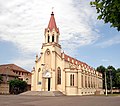Our Lady of Navigators: Difference between revisions
No edit summary |
No edit summary |
||
| Line 1: | Line 1: | ||
[[Image:IN02.jpg|thumb|right|Statue of ''Our Lady of Navigators'' at the [[Our Lady of Navigators church (Porto Alegre)|Our Lady of Navigators church]], [[Porto Alegre]], [[Brazil]].]] |
[[Image:IN02.jpg|thumb|right|Statue of ''Our Lady of Navigators'' at the [[Our Lady of Navigators church (Porto Alegre)|Our Lady of Navigators church]], [[Porto Alegre]], [[Brazil]].]] |
||
'''Our Lady of Navigators''' also known as '''Our Lady of Seafarers''' (''Nossa Senhora dos Navegantes'' in [[Portuguese language|Portuguese]]) is a devotional title given to the [[BVM(RC)|Virgin Mary]] by [[RCTerm|Roman Catholic]]s. It is a widespread devotion in South America, specially [[Brazil]], where the '''Our Lady of Navigators''' is celebrated on February |
'''Our Lady of Navigators''' also known as '''Our Lady of Seafarers''' (''Nossa Senhora dos Navegantes'' in [[Portuguese language|Portuguese]]) is a devotional title given to the [[BVM(RC)|Virgin Mary]] by [[RCTerm|Roman Catholic]]s. It is a widespread devotion in South America, specially [[Brazil]], where the '''Our Lady of Navigators''' is celebrated on February 2nd as an official holiday. Religious procession where the image of the Virgin Mary is carried take place in most coastal cities that have harbors, specially the large ones. Several churches in Brazil are dedicated to Our Lady of Navigators.<ref>Candice Lee Goucher, 2007 ''World history: journeys from past to present'' ISBN 0-415-77137-4 page 102</ref><ref>Vicente del Rio, 2009 ''Contemporary urbanism in Brazil'' ISBN 0-8130-3281-4 page 189</ref> |
||
The devotion started in the fifteenth century by Europeans, especially the Portuguese navigators, praying for a safe return to their homes. They saw the Virgin Mary as their protector during storms and other hazards. The first statue in South America was brought from Portugal to Brazil. |
The devotion started in the fifteenth century by Europeans, especially the Portuguese navigators, praying for a safe return to their homes. They saw the Virgin Mary as their protector during storms and other hazards. The first statue in South America was brought from Portugal to Brazil. |
||
Revision as of 21:23, 9 December 2013

Our Lady of Navigators also known as Our Lady of Seafarers (Nossa Senhora dos Navegantes in Portuguese) is a devotional title given to the Virgin Mary by Roman Catholics. It is a widespread devotion in South America, specially Brazil, where the Our Lady of Navigators is celebrated on February 2nd as an official holiday. Religious procession where the image of the Virgin Mary is carried take place in most coastal cities that have harbors, specially the large ones. Several churches in Brazil are dedicated to Our Lady of Navigators.[1][2]
The devotion started in the fifteenth century by Europeans, especially the Portuguese navigators, praying for a safe return to their homes. They saw the Virgin Mary as their protector during storms and other hazards. The first statue in South America was brought from Portugal to Brazil.
The theme of the "Virgin Mary as the protector" was similarly used in the The Virgin of the Navigators, 1531–36, the earliest known painting whose subject is the discovery of the Americas.[3][4]
See also
- Virgin of Mercy
- Our Lady, Star of the Sea
- Ave Maris Stella
- Roman Catholic Marian art
- The Virgin of the Navigators
- Our Lady of Navigators church
Gallery of churches
Notes
| Part of a series on the |
| Mariology of the Catholic Church |
|---|
 |
|
|
- ^ Candice Lee Goucher, 2007 World history: journeys from past to present ISBN 0-415-77137-4 page 102
- ^ Vicente del Rio, 2009 Contemporary urbanism in Brazil ISBN 0-8130-3281-4 page 189
- ^ John Noble, Susan Forsyth, Vesna Maric, Paula Hardy. Andalucía. Lonely Planet, 2007, p. 100
- ^ Silvio Bedini, 1991 The Christopher Columbus encyclopedia ISBN 0-13-142670-2 page 318
Sources
External links
- Capela de Nossa Senhora dos Navegantes, Ilhavo pt:Capela de Nossa Senhora dos Navegantes
- Igreja de Nossa Senhora dos Navegantes, Parque das Nações [3]



